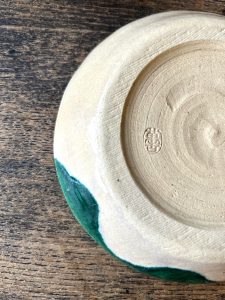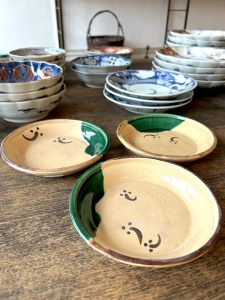温かくてほっこりするお皿です(愛知県名古屋市千種区姫池通 骨董買取 古美術風光舎)
2023.12.16
皆さまこんにちは。スタッフHでございます。
今年はインフルエンザが猛威を振るっているようですね。年の瀬でなにかと忙しい時期ですが、無理をなさらず体調に気を付けてお過ごしください。
さて、最近店内でよく視線を向けてしまうお皿があります。明治から大正時代に作られた萬古焼(ばんこやき)、織部写しです。素朴さと温かみのある色合いに日々惹かれていく自分がおります。土鍋や急須で有名な萬古焼ですが、それらが生まれる前の銘々皿になります。

香辛料の丁子(ちょうじ)のシンプルな模様がリズミカルで可愛らしい印象です。丁子は「宝尽くし文(たからづくしもん)」という宝物を集めた吉祥文様のなかのモチーフのひとつなのだそうです。中国から伝来の希少品で、香料でもあり薬草でもあり、かつてはとても貴重なお宝とされていました。
先日、織部焼について綴りましたが、「織部写し」という言葉が不思議な感じがして少し調べてみました。「写し」は文字通りコピーなのですが、陶芸作品のタイトルに「写し」がついている時は、贋作や盗作、知的財産権の侵害といったイメージはないとのこと。もともと陶芸作品は同じ窯、同じ土、同じ方法で焼成しても同じものが必ずできるとは限らない難しさがあります。土や釉薬の成分のわずかな違いが作品の見た目を大きく左右するので、寸分たがわぬものを作るには相当な知識と経験が必要になるとのこと。そのため陶磁器の「写し」は技術のある人の仕事として称賛されるものと捉えられています。写しの元となった作品は、和歌の本歌取りにならって「本歌」と呼ばれます。なんと洒落たネーミングでしょう。
本歌に敬意を払い、腕のいい職人が写しとして作る。元の作品の良さも残しつつ、自分の個性を加えることもできます。また素晴らしい作品を真似ることは技術の向上につながると考えられています。先日綴った能面の「本面」を写す作業に通ずるものがあります。基本を習得することは、のちに個性を発揮する土台として不可欠なのかもしれません。
さて、萬古焼は現在、三重県四日市市の地場産業ですが、元は江戸時代中期に桑名の豪商であった沼波弄山(ぬまなみろうざん)が三重県朝日町に窯を開いたことに始まります。弄山の作品に「変わらず永遠に残るように」という意味の「萬古不易」という文字が入っていたことから萬古焼と呼ばれるようになったという説もあります。土地の名前が入っていないのは珍しいですね。

弄山の死後一時廃れてしまいますが、同じく桑名の古物商、森有節(もりゆうせつ)が復活させ、明治3年に山中忠左衛門が四日市に窯を開き量産を開始しました。
萬古焼は陶器と磁器の中間的な性質を持つ半磁器に分類され、耐熱性に優れているため土鍋等の調理器具が数多く生産されています。また急須は紫泥とういう鉄分を含んだ赤土を用い、釉薬をかけずに焼いています。土に含まれる鉄がお茶の渋み成分のタンニンと反応し、渋みを和らげ旨味を出してくれるそうです。
鉄瓶もいいですが、萬古焼の土瓶も欲しくなってきました。年末にかけて財布の紐が緩んでしまいそうです。
それでは、またお会いしましょう。

Hello everyone. This is Staff H.
The flu seems to be raging this year. It is the end of the year and we are all busy, but please take care of yourselves and don’t overexert yourself.
Recently, there is a plate in the store that often catches my attention. It is an Oribe copy of Banko-yaki made in the Meiji and Taisho periods. The simplicity and warmth of the colors attract me every day. Banko-yaki is famous for earthenware pots and kyusu (teapots), but this is a plate from before those were created.
The simple pattern of the spice “choji” is rhythmical and lovely. It is said that “choji” is one of the motifs of “Takarazukushimon,” a collection of treasures with auspicious motifs. It is a rare item that came from China, and was once considered a very valuable treasure as it was both a perfume and a medicinal herb.
The other day, I wrote about Oribe ware, but the term “Oribe copy” seemed strange to me, so I did some research. The word “copy” is literally a copy, but when “copy” is attached to the title of a ceramic work, there is no image of forgery, plagiarism, or infringement of intellectual property rights. Originally, ceramic works have the difficulty that the same kiln, the same clay, and the same method of firing do not always produce the same piece. The slightest difference in the composition of the clay and glaze can greatly affect the appearance of a piece, so a great deal of knowledge and experience is required to produce an exact replica. For this reason, “copying” ceramics is seen as the work of a skilled craftsman to be admired. The original work of copying is called “honka,” which is a reference to the honka-tori in waka poetry. What a stylish name!
A skilled craftsman makes a copy of the original work, paying respect to the original poem. While preserving the quality of the original work, one can also add one’s own individuality. It is also believed that imitating a great piece of work leads to improvement in technique. This is similar to the process of copying “honmasks” of Noh masks, which I wrote about the other day. Mastering the basics may be indispensable as a foundation for later developing one’s individuality.
Banko-yaki is now a local industry in Yokkaichi City, Mie Prefecture, but its origins date back to the mid-Edo period, when Numanami Rozan, a wealthy merchant in Kuwana, opened a kiln in Asahi-cho, Mie Prefecture. Some say that the name “Banko-Yaki” came about because Tossan’s works contained the characters “Banko Fueki,” meaning “to remain unchanged and eternal. It is rare that the name of the land is not included.
After Tossan’s death, Banko-yaki was temporarily discontinued, but was revived by Mori Yusetsu, an antique dealer also from Kuwana, and in 1898 Yamanaka Chuzaemon opened a kiln in Yokkaichi and began mass production.
Banko-yaki is classified as a semi-porcelain ware that has properties between those of ceramics and porcelain, and many earthenware pots and other cooking utensils are produced due to its excellent heat resistance. The teapots are made of purple clay, a red clay that contains iron, and are fired without glaze. The iron contained in the clay reacts with tannin, the astringent component of tea, to soften the astringency and bring out the flavor.
Tetsubin is good, but I also want to buy a Banko-yaki earthenware kettle. I think my purse strings will be loosened toward the end of the year.
I will see you soon.
*******************
ご実家の整理やお片付けなどをされている方のご相談などが多くございます。
お片付けなどくれぐれもご無理のないようになさってくださいませ。
風光舎では古美術品や骨董品の他にも絵画や宝石、趣味のお品など様々なジャンルのものを買受しております。
お片付けをされていて、こういうものでもいいのかしらと迷われているものでも、どうぞお気軽にご相談下さいませ。
また風光舎は、出張買取も強化しております。ご近所はもちろん、愛知県内、岐阜県、三重県その他の県へも出張いたします。
まずは、お電話お待ちしております。
愛知県名古屋市千種区姫池通
骨董 買取
【古美術 風光舎 名古屋店】
TEL052(734)8444
10:00-18:00 OPEN
#出張買取#骨董#古美術#骨董品#絵画#版画#茶道具#刀剣#彫刻

